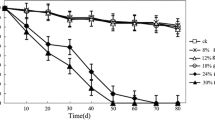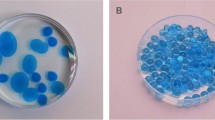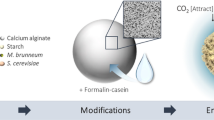Abstract
Despite many advantages of employing entomopathogenic nematodes (EPNs) as biocontrol agents against soil-dwelling insect pests, their use is still limited to home gardening or small-scale farming. Lack of cost-effective, durable formulations, as well as appropriate application methods have so far prevented the use of EPN in large-scale farming. A recent report on alginate capsules as a novel EPN formulation for application into the soil shows promise. However, EPNs often readily escaped from these capsules within a few days especially when they are not refrigerated. To improve EPN retainment, we adjusted capsule properties by changing the reaction temperature for capsule formation and by adopting post-treatment of alginate capsules with excessive Ca2+, and then evaluated EPN escape from the capsules manufactured under different conditions. While capsules with the hardest capsule shell were produced at 4 °C with the Ca2+ post-treatment, the 40 % enhanced EPN retainment was achieved only by lowering the reaction temperature.





Similar content being viewed by others
References
Gaugler R, Lewis E, Stuart RJ (1997) Ecology in the service of biological control: the case of entomopathogenic nematodes. Oecologia 109:483–489
Georgis R, Kaya HK (1998) Formulation of entomopathogenic nematodes. In: Burges HD (ed) Formulation of microbial biopesticides. Kluwer Academic Publishers, Dordrecht, The Netherlands, pp 289–308
Georgis R, Koppenhöfer AM, Lacey LA, Bélair G, Duncan LW, Grewal PS, Samish M, Tan L, Torr P, van Tol RWHM (2006) Successes and failures in the use of parasitic nematodes for pest control. Biol Control 38:103–123
Hiltpold I, Hibbard BE, Wade French B, Turlings TCJ (2012) Capsules containing entomopathogenic nematodes as a Trojan horse approach to control the Western corn rootworm. Plant Soil 358:11–25
Hoffman AS (2012) Hydrogels for biomedical applications. Adv Drug Deliv Rev 64:18–23
John RP, Tyagi RD, Brar SK, Surampalli RY, Prévost D (2011) Bio-encapsulation of microbial cells for targeted agricultural delivery. Crit Rev Biotechnol 31:211–226
Kaya HK, Gaugler R (1993) Entomopathogenic nematodes. Annu Rev Entomol 38:181–206
Kaya HK, Nelsen CE (1985) Encapsulation of steinernematid and heterorhabditid nematodes with calcium alginate: a new approach for insect control and other applications. Environ Entomol 14:572–574
Kaya HK, Stock SP (1997) Techniques in insect nematology. In: Lacey L (ed) Manual of techniques in insect pathology. Academic Press, San Diego, USA, pp 281–324
Kaya HK, Mannion CM, Burlando TM, Nelsen CE (1987) Escape of Steinernema feltiae from alginate capsules containing tomato seeds. J Nematol 19:287–291
King AH (1982) Brown seaweed extracts (alginates). In: Glicksman M (ed) Food hydrocolloids. CRC Press, Boca Raton, USA, pp 115–188
Koppenhöfer AM (2007) Nematodes. In: Lacey LA, Kaya HK (eds) Field manual of techniques in invertebrate pathology, 2nd edn. Springer, Berlin, Germany, pp 249–264
Lewis EE, Campbell J, Griffin C, Kaya H, Peters A (2006) Behavioral ecology of entomopathogenic nematodes. Biol Control 38:66–79
Peters A (1996) The natural host range of Steinernema and Heterorhabditis spp. and their impact on insect populations. Biocontrol Sci Technol 6:389–402
Shapiro-Ilan DI, Jackson M, Reilly CC, Hotchkissa MW (2004) Effects of combining an entomopathogenic fungi or bacterium with entomopathogenic nematodes on mortality of Curculio caryae (Coleoptera: Curculionidae). Biol Control 30:119–126
Shapiro-Ilan DI, Gouge DH, Piggott SJ, Fife JP (2006) Application technology and environmental considerations for use of entomopathogenic nematodes in biological control. Biol Control 38:124–133
Shapiro-Ilan DI, Han R, Dolinksi C (2012) Entomopathogenic nematode production and application technology. J Nematol 44:206–217
Tønnesen HH, Karlsen J (2002) Alginate in drug delivery systems. Drug Dev Ind Pharm 28:621–630
Vemmer M, Patel AV (2013) Review of encapsulation methods suitable for microbial biological control agents. Biol Control 67: 380–389
Acknowledgments
We thank Dr. Thomas Degen for his illustration included in this paper. This work was supported by a grant from the Swiss National Science Foundation (Grant No. 51NF40-144621).
Author information
Authors and Affiliations
Corresponding author
Additional information
Handling Editor: Ralf Ehlers.
Electronic supplementary material
Below is the link to the electronic supplementary material.
10526_2014_9638_MOESM1_ESM.tif
Fig. S1. The capsule hardness tester used in this research (Illustration: Dr. Thomas Degen). The tester is made of aluminum except for the plastic base. Details on the dimensions of the capsule holder are also provided. The devise is used by placing a Ca2+-alginate capsule in the capsule holder and pulling down the spring scale (Pesola AG, Baar, Switzerland) until the capsule bursts, at which the scale is recorded. Measurements were made with a 300-g spring scale instead of a 1-kg spring scale shown in the figure. (TIFF 1143 kb)
Rights and permissions
About this article
Cite this article
Kim, J., Jaffuel, G. & Turlings, T.C.J. Enhanced alginate capsule properties as a formulation of entomopathogenic nematodes. BioControl 60, 527–535 (2015). https://doi.org/10.1007/s10526-014-9638-z
Received:
Accepted:
Published:
Issue Date:
DOI: https://doi.org/10.1007/s10526-014-9638-z




